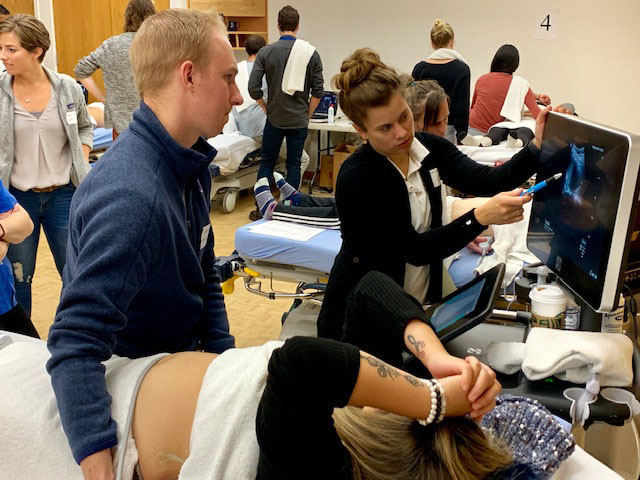
Rural family medicine residents from the University of Calgary’s Cummings School of Medicine (U of C CSM) gathered on a snowy Saturday in Lethbridge recently to learn how using point-of-care ultrasound can make a difference in an emergency situation.
Dr. Kevin Janz, Chief Resident of the Rural Family Medicine program at the U of C CSM, says that, in a rural setting, a quick and effective ultrasound image can make a critical and, sometimes, life-saving difference in diagnoses.
“As new medical graduates, we’re all aware of what the standard of care is moving toward,” says Janz. “We all felt ultrasound is a skill set that [is] really valuable, especially given that we’re in a rural program. Working in acute-care settings in rural sites, you need to be ready for anything, and we just want to set ourselves up for success by being able to offer the best patient care we can.”
“In a rural hospital setting, you don’t have teams or departments of specialists at your disposal, so being equipped with diagnostic tools and knowledge, like the type we’re learning here today, can make a significant difference for patient-care outcomes,” Janz explained.
“Working in acute-care settings in rural sites, you need to be ready for anything…”
– Dr. Kevin Janz
Emergency Department Echo (EDE) Course instructor and acute-care-trained nurse practitioner, Dal Lydns, believes the ultrasound education being imparted to the rural family medicine residents is something they’ll be able to build upon and continue to use well into their careers.
“This [course] is the first step in a series these residents can take which will further enable them to provide better patient care in emergency situations and in everyday care,” says Lydns. “Today, they’ll walk away with all the basic skills they’ll need in an emergency environment, [knowing] how to handle the probe and … how to determine what is a good scan to use and what isn’t. It’s a good safety net of skills they can apply practically.”
Second-year rural family medicine resident, Dr. Brittany Albreicht, says, while she’s worked with ultrasound before, this course gives her not only the certification to use ultrasound in her practice, but solidifies the knowledge and skills she has learned to date.
“This is definitely an essential tool
for us to be able to use.”
– Dr. Brittany Albreicht
“Compared to an urban-based program, we do a lot more work in urgent care … especially the emergency department where you don’t necessarily have a CT scanner at your disposal. This is definitely an essential tool for us to be able to use.”
Medicine-Hat-based, first-year resident, Dana Nielsen, says he had limited experience with ultrasound, so this course provides him with skills and confidence to utilize the tool in his residency and, ultimately, his future practice.
“Where I see this being a major benefit is when I hear something going on in someone’s heart for example, I’ll be able to actually see what is happening in a timely way,” says Nielsen. “That image or scan could potentially make a big difference in the patient’s care outcome.”
The EDE Course was sponsored by the Rural Health Professions Action Plan (RhPAP), which means all of the education, skills, and certifications came at no expense to the residents, something Janz says is incredibly valuable.
“That image or scan could potentially make a big difference in the patient’s care outcome.”
– Dana Nielsen
“We are so very appreciative that RhPAP could cover the cost of this course today as it provides invaluable education and experience that we would otherwise be personally paying out of pocket for,” says Janz. “This education directly impacts how we approach care for patients and we can’t thank them enough.”
The EDE Course was developed by Dr. Ray Wiss, a Canadian military physician who is recognized for introducing the use of ultrasound into Canadian emergency medical practice. His EDE Course has been taught to more than 15,000 Canadian and international physicians and allied health professionals. The course has become the standard of care in large trauma centres, remote settings, and by Canadian Armed Forces combat units in Afghanistan.
